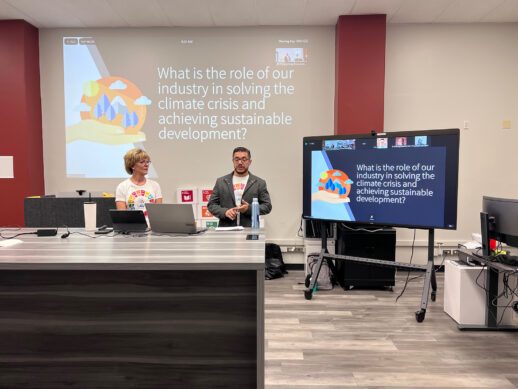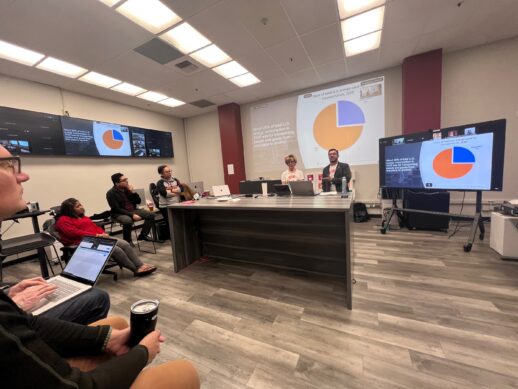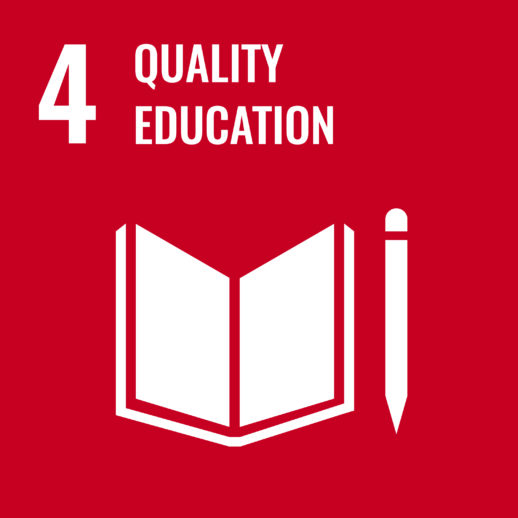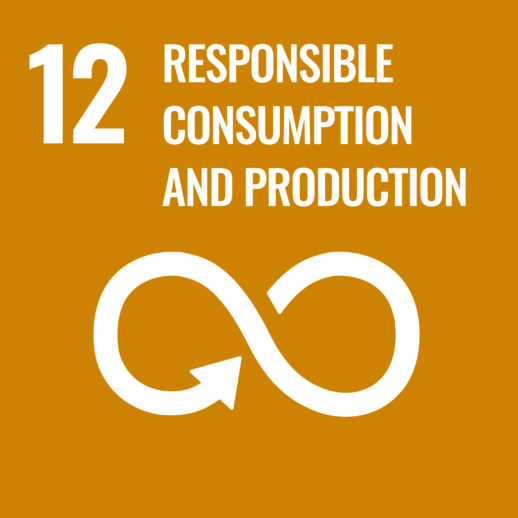Embracing the 2030 Sustainable Development Goals (SDGs) at USC

SAVe co-founders Christina De Bono and Joe Perez kick off the workshop at USC. Photo: Lorenzo Bernardi and the University of Southern California
Adding to its stature as one of the world’s leading private research universities, the University of Southern California enjoys international recognition for its leading-edge classroom educational technology, managed by USC’s ITS Learning Environments Department. In the winter of 2023, under the leadership of director Joe Way, the Learning Environments Department became the first university entity in America to achieve SAVe Certification, a designation granted by Sustainability in AV (SAVe), the nation’s first US-based industrywide organization to bring stakeholders in the audiovisual (AV) field together to take concerted action to achieve the 2030 Sustainable Development Goals (SDGs).
The Learning Environments Department’s embrace of SAVe Certification goes hand-in-hand with a university-wide commitment to advancing sustainability, as evidenced by Assignment: Earth, USC’s sustainability framework for a greener campus and planet. The sweeping program was authored by the USC Presidential Working Group on Sustainability in Education, Research and Operations with input from teams across the university. USC has also established The Center for Sustainability Solutions, an academic catalyst for the development of policy, technological and behavioral solutions to the most pressing sustainability problems of the Southern California region and the world.
The SAVe Certification process
“It’s not enough to raise awareness. If we’re to make real progress in achieving the 2030 Sustainability Goals (SDGs), the AV industry has to take concerted, meaningful, measurable action to address the issues that threaten not just our sustainability, but our very survival,” says SAVe co-founder Christina De Bono.
But where to start? What can individual organizations do to develop a plan of action that is in itself sustainable across their company and over time?
This is where SAVe Certification comes in. A program for companies in the AV industry, SAVe Certification provides a framework for organizations to develop and execute a plan to help achieve the 2030 Sustainable Development Goals.
The Certification progress begins with an assessment, moderated by a SAVe facilitator and attended by company leadership and staff. Over the course of two half-day sessions, participants identify which of the 2030 SDGs – and specific sustainability targets under each goal – most align with their organization’s business model.
The second phase of SAVe Certification involves the development of specific strategies to achieve the targets and to measure the organization’s progress against those targets.
Upon completion of the assessment and development of a sustainability plan, the organization becomes SAVe Certified. This is an earned credential that can be used to inform clients, vendors, staff and other stakeholders of an organization’s active commitment to achieving the 2030 SDGs. SAVe Certified organizations also have access to all the resources SAVe provides to advance sustainability in the AV industry.
SAVe Certification at USC

Christina De Bono and Joe Perez of SAVe present to members of USC’s ITS Learning Environments Department.
Photo: Lorenzo Bernardi and the University of Southern California
In the Fall of 2022, SAVe Co-Founders Christina De Bono, Thuy To and Joe Perez conducted a SAVe Certification assessment in the ITS Learning Environments Department at the University of Southern California (USC).
The ITS Learning Environments Department oversees the design, installation, and support for the 500+ AV-enabled classrooms, conference rooms, auditoriums, computer labs, and study spaces across the USC enterprise. Its mission is to create a highly available and intuitive teaching-and-learning educational technology experience for the campus community through sustainable, accessible, and safe user-centered environments.
One of the world’s leading private research universities with an enrollment of 44,000 students, USC is an anchor institution in Los Angeles and a global center for arts, technology and international business. Its diverse curricular offerings provide extensive opportunities for interdisciplinary study and collaboration with leading researchers in highly advanced learning environments.
USC’s Save Certification assessment consisted of a 3-part workshop held over a day and a half. Thirteen members of the 14-person department were able to attend both sessions.
FIRST – ALL-STAFF WORKSHOP
Part 1 – 45 minutes
- Attendees were briefed on the day’s objectives and introduced to the 17 Sustainable Development Goals via a short video.
- Attendees were randomly assigned cards listing two Sustainable Development Goals, and partnered with others who had drawn the same cards.
Part 2 – 45 minutes
- Participants brainstormed with their group on how to align their workflows with their assigned SDGs, or what they could do personally to advance their SDGs.
- Ideas were posted throughout the room on large Post-It notes.
Part 3 – 45 minutes
- Each group was assigned a team lead who presented their ideas to the larger group.
SECOND – LEADERSHIP-TEAM WORKSHOP
In the second part of the SAVe Certification process, members of the leadership team met to review the results from Day 1 of the workshop and decide which areas held the most promise for progress.
Part 1 – 60 minutes
- The leadership team discussed how their organization can align with the SDGs.
- The team chose the SDGs that align most closely with their business model.
Part 2 – 60 minutes
- The team broke into smaller groups, each of which was assigned an SDG that the organization would like to focus on.
- Team members brainstormed ideas on actions that could be taken to address the SDGs, and recorded them on a SAVe Certification worksheet.
THIRD – LEADERSHIP-TEAM SDG PLAN FORMULATION
In the final part of the SAVe Certification process, members of the leadership team reconvened to create an actionable plan.
Part 3 – 90 minutes
- Leadership chose the actions they wished to implement and entered them on their worksheet as a team.
- For each action chosen, the team began to formalize steps to achieve, sustain and measure progress. This formed the foundation for a complete action plan.
Results of the ITS Learning Environments Department SAVe Certification
At the conclusion of the SAVe Certification workshop, the ITS Learning Environments Department team identified a long list of tactics to be incorporated into an SDG action plan. Among them:
SDG GOAL 4: QUALITY EDUCATION
Ensure inclusive and equitable quality education and promote lifelong learning opportunities for all.
- Create an educational program for USC, providing a campus-wide introduction/overview of the 2030 Sustainable Development Goals
- Plan & design a “Lunch ‘n Learn” for a Power Consumption Campaign with the intent of spreading awareness, building knowledge, and adopting better power-consumption practices – Spread/share Power Consumption Campaign lesson plan with SAVe and HETMA (the 600 colleges and universities that are members of the Higher Education Technology Managers Association)
- Develop a “Train the Trainer” program to enable SAVe Certification on a larger scale
- Develop a SAVe Certification Program, including documents and videos, to scale up SAVe Certification to make it more accessible for the Higher Ed & AV Industry
- Develop an InfoComm SAVe Certified course for AVIXA members
- Develop an EduCause SAVe Certified document for member organizations
- Hold an EduCause-SAVe Panel Discussion with SAVe, HETMA, EduCause, and SAVe Certified Higher Ed organizations to bring stakeholders in Higher Ed together to take collective action to achieve the SDGs
- Develop an ITS Trojan Learn SAVe Certification course for the USC Trojan Family
SDG GOAL 12: RESPONSIBLE CONSUMPTION AND PRODUCTION
Ensure sustainable consumption and production patterns. 
- Update RFPs for architects, engineers and others bidding on educational technology projects, reflecting USC’s goal of advancing the SDGs and leading to a standardized RFP for the entire USC campus
- Develop educational practices to enable USC departments to incorporate sustainability into RFPs, with the goal of progressing on the path of USC’s 2030 Net Zero Classroom goals
- Adopt new power management practices/standards for the USC campus
- Develop time schedules and OCC equipment to achieve better power management in accord with USC goals
- Specify metric-capable equipment capable of tracking certification goals
- Develop metric analysis practices to track the performance of technology inventory
- Analyze technology inventory and current equipment to determine what can be
recycled and reused - Use SAVe-approved technology recyclers to ensure the proper recycling and disposal
of equipment that has reached the end of its useful life
SDG GOAL 8: DECENT WORK AND ECONOMIC GROWTH
Promote sustained, inclusive and sustainable economic growth, full and productive employment and decent work for all.
- Utilize work-study to advance the 2030 SDGs
– Partner with the work-study program hiring committee to widen the pool of candidates and structure wage processes for improved equity
– Partner with student supervisors to find sustainable methods and processes, and identify and measure non-subjective performance-based merit increases with the goal of increasing retention, student performance and morale
